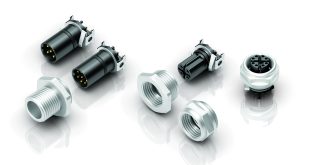Connectors are needed in almost everything. But with the need for things to be smaller, lighter and faster, connectors need to follow this trend, too. CIE editor, Amy Wallington, talks to Peter Dent, managing director of LEMO, about the changes in interconnection and specifically within the military, aerospace and defence industry
Changes in electronics are rapidly taking place all around us in every aspect of our lives. Innovation is impacting almost every industry and the demand for its implementation is growing faster than ever before. In order to keep up with this demand, companies are having to look at ways in which they can change their business profiles to give customers exactly what they need within the required time frame.
There are currently considerable changes taking place in the military, aerospace and defence industries and companies in this market are having to evolve and adapt in order to adhere to these expectations. In particular, LEMO is currently working on developing its business – not just the products and technologies but the services as well. Dent explained: “It’s the shift of UK manufacturing, particularly the OEMs, to outsource any activities that are non-core connector termination. If you look at the defence industry, most of them in the UK, in particular, are focused on system design and integration so they do not manufacture in-house anymore which means we need to offer a complete service. Customers don’t just want to buy connectors, they want to buy a whole “plug and play” interconnect solution.”

To meet this growing demand for “plug and play” interconnect solutions, LEMO has expanded its UK cable assembly service by 50 per cent. This significant investment is supporting the growing manufacturing trend for OEM’s to outsource their non-core connector termination activities.
“It’s all about having a business model which supports the way their businesses work,” said Dent. “LEMO’s aim is to provide its UK customers with increased value by means of offering them a complete cable design and manufacturing service. The objective of this service is to provide customers with bespoke engineered solutions, tailored to specific system requirements and optimised for both performance and manufacturing, from the outset.”
This approach ensures that product costs along with assembly and project lead-times are minimised, without the need for compromises in either performance or quality. As part of offering this complete service, LEMO now provides its customers with access to a knowledgeable cross-functional team who have gained, collectively, 250 years of experience working in the interconnection industry.
“There is a massive shift in the aerospace industry; everything has got to be smaller, lighter and faster which means that connectors are getting smaller so the cables, too, have to be smaller as well,” commented Dent. “So having a highly skilled termination team who are capable of terminating micro connectors is a key part of realising the customer’s overall requirements. People don’t realise that there is a big shift going on in cable assemblies, as before, they were quite bulky and easy to put together but now they are precision interconnectors where you have got micro contacts being terminated and it’s providing a high performance and reliable interface when you scale it down to these margins, that is important. When you scale things down, you introduce new challenges that can have an impact on the industry. A lot of our connectors feature automated assembly because it can no longer be done by hand when they are so small but with cable assembly, it’s very fine work so it is vital to have very dexterous people who are used to doing highly skilled operations and that is where we have invested heavily in order to have the capability to make high quality, reliable “plug and play” cable assemblies. It’s not about mass producing, it’s about exceptional quality, medium to low volume and that is where one of the biggest shifts we have seen, has taken place.”
Something that LEMO has specialised in for a while is fibre optics. Fibre optics is being introduced into the civil aerospace sector, however, it is also used in some military programmes and soon we will start seeing the implementation of fibre more and more into civil and military aircrafts. The architecture is also changing where before, cables would have been running up and down the length of an aircraft, now development engineers want to compress the whole avionics system to be housed into one suite. Dent said: “In the same way as mobile phones have changed in the last 10 years, so has avionics, too – getting smaller and smaller. We get involved with the manufacture of high quality cable assemblies but the difference is that we are getting involved in the concept and development of the solution with the customer, optimising it for both design and manufacture. If you don’t include that manufacturing element at the beginning of the process, then you have a major cost impact, later. If you get involved at the beginning of the project, the cost doesn’t necessarily change.”
Dent continued: “We have got a cross functional team that we are making available to our customers which means it’s not just design engineers, it’s manufacturing engineers getting involved at the outset of a project. We are becoming more of an extension to their development team rather than a sub-contractor or a supplier.”

It’s not just in the aerospace, military, defence and space where there are changes with interconnection, but auto sport is another area where there is considerable evolution. “Back in the 1980s, aerospace and auto sport companies were sharing R&D and what happened was a number of auto sport were using military connectors,” explained Dent. “The first auto sport connectors being used were standard military ones which were ruggedized to provide high reliability. However, auto sport wanted to surge forward with the innovation of Formula 1 acting as a major driving force so they then worked with LEMO, as one of the companies, to develop the next generation of connectors. We were being pushed harder by auto sports so LEMO has now developed the next generation of micro, high reliability connectors well ahead of civil and military defence requirements.
“In auto sport, it’s a very quick cycle from one season to the next and that’s why our connectors are smaller and lighter than any of our competition because we were constantly evolving in the faster paced world of Formula 1.”
As auto sport and military requirements are so similar, LEMO are able to work in both industries and build the same connectors for both. They need to be able to withstand high vibration, have high reliability, need to be rugged and, finally, require to be corrosion-resistant. LEMO are now selling these connectors, used in auto sport, back into the military market. Dent concluded: “We started in military, diverged to auto sport and are now converging again back to military with considerable product offerings for both markets.”
There is no doubt that fibre optics will become more and more prevalent in the defence and aerospace industry. The changes come with the transformation of requirements from the customers and the evolution of technology. We are certainly likely to see more of this revolution, not just in our sector but in other industries, too.
 CIE Components in Electronics
CIE Components in Electronics



